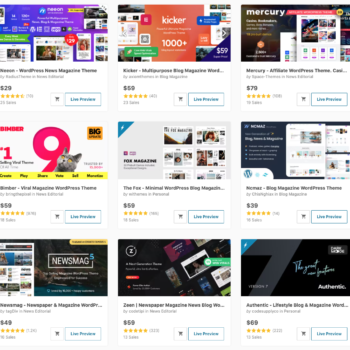Starting a blog is exciting! There are ideas buzzing in your head, maybe you’ve even got a cool domain name picked out, and you’re ready to share your knowledge, stories, or passions with the world. But then you open up that blank post editor…and suddenly, nothing. That spark of excitement fizzles, replaced by a whole lot of self-doubt.
Trust me, you’re not alone. Every single blogger has stared at a blank screen, wondering if they have anything worthwhile to say. The good news is, you absolutely do! And even better, getting that first blog post written doesn’t have to be the impossible task it might feel like right now.
In this guide, I’m walking you through a simple process to go from that dreaded blank page to hitting “publish” on your very first post. No fancy blogger lingo, no complex strategies – just the beginner-friendly steps to get started.
Step 1: Forget Perfection, Focus on Finished
The biggest hurdle to writing your first blog post isn’t a lack of ideas – it’s perfectionism. We want our very first attempt to be a masterpiece. Spoiler alert: it won’t be. And that’s perfectly okay! The reality is, your first few (or even dozen) blog posts will probably not be your best work, and that’s how you learn.
Think of it like baking: your first attempt at a fancy cake might collapse. Does that mean you give up on baking forever? Of course not! You analyze what went wrong, tweak the recipe, and try again. Blogging is the same.
Right now, your goal isn’t to become the next internet writing sensation. The goal is to get something – anything – out into the world. A finished, even if imperfect, blog post is infinitely more valuable than a brilliant idea stuck in your head.
Why Perfectionism Kills First Posts
- Stuck in Editing Limbo: You agonize over every sentence, endlessly tweaking instead of making progress on the post as a whole.
- Fear of Judgment: Even if no one actually criticizes your early work, the fear of what they might say prevents you from sharing at all.
- Missed Learning Opportunities: You don’t get the valuable feedback (from readers, or your own analysis) that helps you grow as a blogger until you publish.
Step 2: The Brainstorm Dump
Okay, now that we’ve kicked that pesky perfectionism to the curb, it’s time to get some actual ideas down! This step is all about quantity over quality. The goal is to wrangle all those thoughts swirling around in your head and get them onto paper (or into a digital document, let’s be real!).
Grab a notebook, open a fresh document, and set a timer for 10 minutes. Your task is to write down everything that could be a potential blog post topic. Don’t judge, don’t analyze, just brain-to-page as fast as you can.
Topics to Spark Your Thinking:
- Hobbies & Passions: Do you bake, rock climb, build websites, or restore vintage furniture? There’s an audience for that!
- Problems You Solve: Are your friends always asking your budgeting advice? Is your inbox filled with people seeking your tech expertise? You can help others!
- Strong Opinions: Don’t shy away from controversial topics (within reason!), those often make engaging posts.
- Your Own Journey: If you’re starting a blog to document weight loss, travel, or overcoming a challenge, your story is valuable from day one!
Important Note: This is NOT your final topic list. It’s just the raw material to work with. Some ideas will be duds, but there might be a few hidden gems in there too!
Step 3: Pick Just ONE Idea
Chances are, your brainstorm dump resulted in a page (or more!) of potential topics. This is great, but it can also feel like too much of a good thing, especially as a beginner. Decision paralysis is real, and it’s another sneaky way our brains try to sabotage that first blog post.
Don’t worry, here’s a simple way to pick your winner:
Criteria for Your “Starter” Post:
- Know a Little Bit: You don’t need to be an expert, but enough familiarity to write a few paragraphs without needing tons of research.
- Feel a Spark: Maybe it’s not your most passionate topic, but there should be at least a tiny flicker of excitement about writing it.
- See Some Structure: You can envision at least 3-5 main points or subtopics you could cover within this post.
Example Time!
Let’s say your brainstorm list includes:
- “Gluten-Free Baking Tips”
- “How I Organize My Closet on a Budget”
- “My Favorite Books of the Year”
- “Why Everyone Should Travel Solo Once”
Ask yourself:
- Which do you already know enough about to start writing confidently?
- Which excites you most (even a little) to share?
- Which can you break down into smaller, clear sections?
It’s okay if more than one fits the criteria! Then, just choose the one that feels most manageable for a first post. Remember, progress is more important than picking the “perfect” topic.
Now that you have your first post idea, it’s time to give it the most basic structure with a super simple outline. Let’s tackle that next!
Step 4: The Super Simple Outline
If the word “outline” makes you break out in a cold sweat, don’t worry. For your first blog post, we’re ditching any complex formatting and focusing on getting the basic bones of your idea on the page.
Think of it like a simple bullet-point list:
- Main Idea: What’s the core thing you want to teach or share in this post?
- Supporting Points: What are the 3-5 key steps, tips, or aspects of the topic you want to cover?
- Wrap-Up: How will you summarize or leave the reader with something to think about?
“How to Make the Perfect PB&J” Example:
- Main Idea: Making a delicious peanut butter and jelly sandwich is easy with the right technique.
- Supporting Points:
- Choose your ingredients wisely (bread, PB type, jelly flavor).
- The perfect spread ratio matters.
- Cutting it diagonally is the superior presentation.
- Wrap-Up: Now go enjoy your perfect PB&J creation!
Why So Simple?
The goal with this first post outline is to get you WRITING. You can always learn more complex outlining later. Right now, having any sort of roadmap helps prevent staring at a blank screen, unsure where to begin. It gives you those first words to build upon.
Up next, the moment you’ve been waiting for: how to write without worrying about whether it’s any good…yet!
Step 5: Write Without Worry
This is the step where many first-time bloggers get stuck. They worry about spelling, about grammar, about whether their sentences sound smart enough, or if anyone will even care what they have to say. Let me tell you right now: push those thoughts aside!
Your first draft is allowed to be messy. In fact, it’s supposed to be messy. The goal is to get your ideas from your head and onto the page. Here’s how to make it less intimidating:
- Turn Off Your Inner Editor: Repeat after me: “I will fix all the mistakes later.” Typos, awkward phrasing – none of it matters right now.
- Write Like You Talk: Don’t try to sound like a textbook. The more conversational your writing feels, the easier it’ll flow.
- Chunk it Up: Feeling overwhelmed by a whole post? Just focus on writing one section of your outline at a time. Take breaks, come back to it – don’t pressure yourself to finish it all in one go.
Pro-Tip: If getting words on the screen is the struggle, try dictating your first draft into your phone’s notes app. You can always type and edit it later. The point is getting those ideas out!
Once you’ve got a rough first draft, even if it’s a bit of a jumbled mess, it’s time for a well-deserved breather. We’ll talk about the simple editing process next!
Step 6: The “Let it Sit” Edit
Okay, you’ve conquered the first draft. Give yourself a high-five, because that’s a major accomplishment! Now, the most important part of editing your first post is surprisingly… not editing at all.
Here’s the key: When you step away from your writing for a while (a few hours at minimum, overnight is even better), you come back with fresh eyes. Suddenly, all the awkward sentences, missing words, and places where your idea got a little muddled will practically jump off the page.
Why the “Let it Sit” Approach Works
- Overthinking Burnout: When you write and immediately edit, you’re still in that initial creation mode. It’s hard to spot your own mistakes because your brain “fills in the gaps’ for you.
- Gaining Perspective: Time away allows you to almost become a reader of your own work rather than the writer, making it easier to see where things could be clearer or more engaging.
- Less Frustration: Trying to write and perfect at the same time leads to giving up early. This method makes editing a distinct step, so it feels less overwhelming.
The Bare Minimum Edit:
Once you’ve given your brain a break, here’s your editing to-do list:
- Read it Aloud: This forces you to slow down, catching typos and clunky sentences your eyes might skip over with silent reading.
- Focus on Clarity: Did you explain each of your points in a way that a total newbie to the topic could understand?
- Check the Flow: Do your ideas move logically from one to the next, or does it feel jumbled?
Important Note: Don’t fall into the trap of endless editing at this stage! Get it to a point where it’s clear, decently error-free, and ready to share with the world.
The most exciting step is up next: hitting that PUBLISH button!
Step 7: Hit Publish (and Celebrate!)
You did it! You have a complete blog post, from initial idea to a finished piece ready to be shared. Take a moment (or a whole lot of moments) to feel proud of this accomplishment. Seriously, not everyone who starts a blog actually gets to this stage.
Hitting publish on your very first post is a much bigger win than having the “perfect” post that never sees the light of day. It’s proof that you can do this!
Why Publishing Matters (Even If No One Reads It Right Away)
- Building the Habit: Blogging, like any skill, takes practice. That first post won the mental battle, making the second one feel a bit easier, and so on.
- Actionable Feedback: Once your post is live, you can analyze how people interact with it (if they do at all!). Did they stay on the page? Leave a comment? This data is more valuable than any theoretical advice.
- The Joy of Creation: Sharing something you made with the world is satisfying, even if your initial audience is small.
Call to Action: I want to celebrate with you! Share the link to your first blog post in the comments below. We can all share some encouraging words.
What’s Next?
Now that you’ve broken the first-post barrier, it’s time to keep going! Remember, consistency matters. Here’s what to focus on:
- Pick a Schedule: How often can you realistically commit to publishing? Once a week is a great starting point.
- Supporting Content: Check out those other blog post ideas we’ll be [link to outline]. They build on the knowledge you gained writing this first one.
Community is Key: Engage with bloggers in your niche. Supporting others on their journey helps you grow too!









No Comments
Leave a comment Cancel